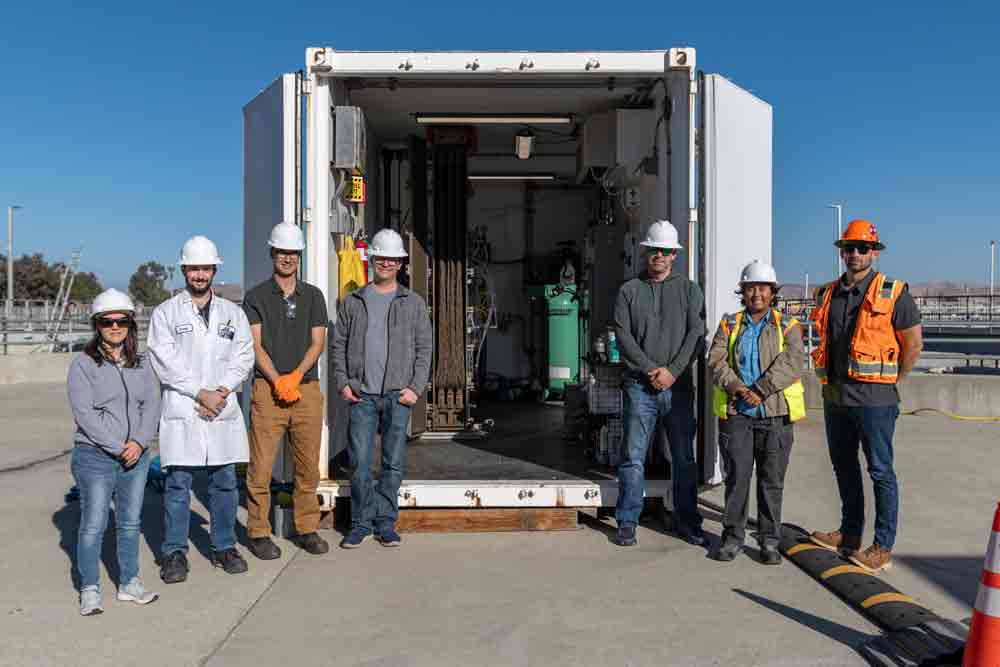
Central San MABR project members: Blake Brown. Brent Harvey, Michael Cunningham, Jesse McDermott, Alan Weer, Brianna Bansraj and Will Grant. Photos by Joe Zumbo.
On July 10, 2024, the San Francisco Bay Regional Water Quality Control Board (RWQCB) approved the third Bay Area Nutrient Watershed Permit, marking the most significant regulation for Central Contra Costa Sanitary District (Central San) since the Clean Water Act was established in 1972. This permit requires a seasonal reduction of 40% in total inorganic nitrogen (TIN), which is the sum of ammonia, nitrate, and nitrite, based on 2022 levels. The new permit limits will come into effect in October 2034, and Central San must start adhering to these load restrictions at the beginning of the 2035 dry season (May 1 to Sept. 30).
“To achieve a 40% TIN reduction using conventional treatment processes, Central San would need to build expensive new aeration basins and clarifiers,” said Central San Associate Engineer Michael Cunningham “The high capital cost (preliminary estimate is about $700 million) and uncertainty, due in part to a large quantity of contaminated soil located in the location most suitable for new secondary process tanks, led us to consider innovative technologies.”
Cunningham went on to say, “Membrane Aerated Biofilm Reactor (MABR) offers an exciting possibility for process intensification, that is, achieving more treatment within our existing basins.”
Central San started an MABR pilot test project prior to the TIN load limits being issued with the goal of maximizing the value of existing infrastructure. The original vision was to maintain the low suspended growth sludge age and add MABR cassettes (as needed) to provide TIN reduction.
From April to November 2024, Central San pilot tested a 2.5-6 gallon per minute (gpm) pilot system supplied by Veolia and local support Coombs Hopkins. HDR, Hazen and Sawyer, and Dr. Glen Daigger provided consulting support.
MABR uses gas-permeable hollow fiber membranes to deliver oxygen to a biofilm. Air flows through the membrane lumen and oxygen diffuses outwardly through the lumen wall. Ammonia diffuses through the biofilm from the wastewater and uses the delivered oxygen at the membrane surface to convert ammonia to nitrate (known as nitrification). The formed nitrate diffuses outwardly towards the bulk solution and is removed at the exterior of the biofilm using available carbon (known as denitrification).
Four core pilot testing objectives were:

Note: Pilot typically fed 4gpm. During periods of “lower flow” shown in Fig. ZZ, feed flow was lowered to 2.5 GPM.
Ammonia removal rates (Fig. ZZ) are comparable and slightly higher than the initial goal of 2.0 grams per square meter of membrane surface area per day. TIN reduction (Fig. YY) was as high as 44% during Phase 3 when the pilot had a lower flow, which allowed the MABR biofilm to remove a greater proportion of the TIN.
TIN reduction was limited in Phases 1 and 2 by available soluble carbon and improved in Phase 3 with higher soluble carbon loading rates. TIN reduction at full scale would depend on the total MABR surface area for biofilm growth and could further improve with the growth of suspended growth denitrifiers, which were not present in the pilot.
“Overall, the pilot results are promising. Given the high TIN load reduction requirements, MABR, in combination with increasing the suspended growth sludge age with or without densification, appears more suitable.” Cunningham said. “As a next step, Central San is considering full-scale demonstration testing of MABR in one of the four existing aeration tanks to confirm site-specific performance.”
Situated in Contra Costa County, approximately one hour east of San Francisco, Central San serves nearly 500,000 residents and over 15,000 businesses across a 146-square-mile service area. Central San operates and maintains a collection system that encompasses more than 1,500 miles of pipelines, 17 pumping stations, 21 miles of force mains, and one wastewater treatment plant in Martinez. The average influent flow at the dry weather treatment plant currently stands at around 32 million gallons per day (MGD), while the peak hourly flow during wet weather can exceed 200 MGD. Solids are converted into ash in a MHF.
The Central San treatment plant underwent a major expansion in 1973, which built the current secondary process tankage. The secondary process operates with an anaerobic selector and short solids sludge age (1.2-1.3 days) for total suspended solids and biochemical oxygen demand removal.